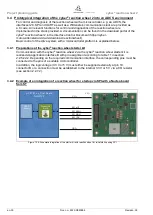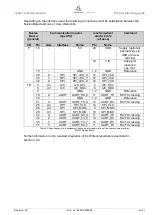
Project planning guide
cyber
®
reaction wheel 2
en-20
Doc. no.: 5022-D060586
Revision: 02
2.2.7.1 Setting the supply voltage
Option 1:
Connect USB port A to a remote end using the provided USB cable.
Option 2:
With the USB cable not connected, a supply voltage can be set within the specified limits via
screw terminal E.
To be able to supply a supply voltage lower than the USB voltage via screw terminal E while the
USB cable is connected, the 0 Ω resistor, R54, must be removed as illustrated in figure 1.8,
block E. In case of frequent changes, a jumper can be refitted for J10.
2.2.7.2 Provision of V-IO for the logic blocks on the starter kit
Except for the signals IO_1 (pin 5, connector B), IO_2 (pin 17, connector B) and IO_3 (pin 18,
connector B), as well as the reserved pins 15 and 16 on connector B, all signals refer to V-IO,
pin 19, connector B. The assignment of connector B is described in section 2.2.5.2.
This voltage must be supplied externally at pin 19 at the external plug connector B. Alternatively,
a connection to the internal 3.3 or 5 V must be established with a 0 Ω resistor:
Figure 1.9: Illustration of the circuit diagram section for supplying the logic
blocks on the cyber
®
reaction wheel starter kit
Notice: The internally generated 3.3 V and 5 V are not intended for supplying external consumers
via pin V-IO_ext.
2.2.7.3 Integration of digital IOs
The digital IOs are decoupled via a series resistance of 100 Ω. The 3.3 V level must always be
complied with:
Figure 1.10: Illustration of the circuit diagram section for the user IOs on
the cyber® reaction wheel starter kit
The two signals IO_1 and IO_2, see section 2.2.5.3, additionally have a red and/or green LED
against GND (high-active) to indicate the status of the reaction wheel. The configuration options
for these two outputs are described in section 2.1.5.3.
0R0 = fit to
connect V-IO to
3.3 or 5 V
















































